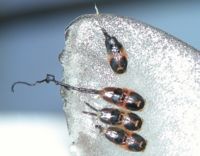| This article has been peer reviewed but is awaiting expert review. If you would like to help with this, please see more information about expert reviewing. |
|
|
Introduction
The crustacea are a large group of arthropods but are usually treated as a subphylum. The majority of crustaceans are aquatic but some have adapted to terrestrial life.
There are only two species of parasitic crustacea of veterinary importance, the tongue worm Linguatula serrata and sealice Lepeophtheirus and Caligus spp.
Sea Lice
- Economic importance to the fish farming industries
- Especially in North American and in Northern Europe
- Lepeophtheirus is found only in the Northern hemisphere
- Caligus is found worldwide
Recognition
- Males measure 6mm in length
- Females measure 1cm long
- Have a long egg sac
- 5 pairs of legs
- 3 pairs for swimming
- 2 pairs modified for eating
- Brown to red in colour
- Similar in appearance to the horse shoe crab
Life Cycle
- Eggs released from long egg sacs into environment
- 2 non-parasitic larval stages
- 7 parasitic larval stages (nauplius)
- Copepod, chalimus and pre-adult
- Life cycle takes 3 weeks to 4 months depending on temperature
Epidemiology
- Largely found in salt water
- Most wild salmonids migrate to the sea for part of their life cycle
- Sealice numbers are low on wild salmonids (adults only)
- Sealice numbers are high on farmed salmonids (larvae and adults)
- 90% prevalence
- Average of 5-10 sealice upon a single fish
- Most sealice found on dorsal fin, head and back and underside of tail and fins
- Adults survive for over 3 weeks
- Migration of larval stages can be up to 1km
- Larvae locate host by responding to changes in light and vibration
Pathogenesis
- Adults and larval stages are epidermal browsers
- Mouth tube of toothed ridges abrades fish epidermis
- Heavy infections leads to:
- Epidermal abrasion
- Haemorrhage
- Immunosuppression
- Decreased productivity
- Death
Control
- Ectoparasiticides
- Hidden antigen vaccine
- Wrasse which feed on sealice
- Management improvements
- E.g. All in, all out and 6 week fallowing
- Stock selection
- e.g. Selective breeding for resistance
